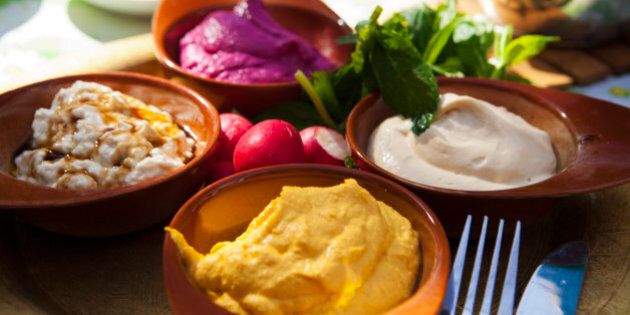
Dips -- helping make carrot sticks appealing since who knows when. But are they actually healthy for you?
"It actually depends upon what type you're choosing and how much you are going to eat," Julie Gilbert, spokesperson for the Dietitians Association of Australia and accredited practicing dietitian, told The Huffington Post Australia.
"The ones you are looking for are the ones made from vegetables or legumes -- so hummus is a good example -- and ones with a low fat dairy component.
"You want to avoid those made with full fat cream cheese, or if they have high quantities of oil. Some have nuts in them as well or a cheese base -- parmesan cheese is a common one -- and these are the things that are going to increase that kilojoule value."
Milena Katz, another accredited practising dietitian and spokesperson for the Dietitians Association of Australia, had a different way of putting it.
"Generally, the thing about dips is that they are a condiment, really," Katz said. "If you eat a whole tub, it’s no different to eating something quite high in energy.
"A lot of them have oil as a base and many have preservative properties as well. If people stick to the recommended serving size it’s not a problem -- but I'd guess people are generally consuming more than a serving in any one sitting."
So how much dip should you really be eating?
"The most important thing is to check the number of serves in the container you are buying," Gilbert said. "While the dip might have wonderful ingredients, when you look at it, the packet says it contains 10 serves even though it's only 100 grams.
"That equates to two teaspoons. Some others you might actually find -- and I'm talking 'healthier' dips like tzatizki and beetroot here -- up to a tablespoon will be a serving size."
Katz agrees that a tablespoon-sized serving is a pretty good rule of thumb for your dips, but also points out what you use to dip with is just important. (It goes without saying things like corn chips are a no-no.)
"Dips are ok -- it really depends on how people eat them and how much," Katz said. "If people won't have celery or other veggie sticks without a bit of hummus -- well it's better than not having any veggies at all.
"But you don't want to be in the situation where you are eating half a tub of dip for the sake of a few carrot sticks."
"For that everyday sort of dip, what's really good to use are things like carrots, celery, beans and cucumber strips," Gilbert added. "If you wanted to have something other than vegetables -- I'd say you could probably have five wheat based crackers per serving, or ten if they are rice-based.
"But generally dips can be a great way of being able to get another vegetable serve into your day without the calories that go with it as well."
No, space sloth, no!
Tzatziki rated fairly highly on both dietitians' list of 'healthy' dips, with hummus also making the cut, though Katz notes "while it can be quite healthy it's also energy rich.
"A spread of hummus on a sandwich if you are not having meat is not a bad option, but in saying that you'd probably be better off having a can of chickpeas in your salad," Katz said.
Guacamole or avocado dip is high in fats and oils, and store-bought dips of this variety should be avoided.
"If someone is really trying to watch their weight, you have to remember [avocado] has quite a bit of energy," Katz said.
"Though if you did want some guacamole, it's much better if you make your own. I haven’t seen one on the market without a preservative. It's much better making it yourself, but having a small amount."
Gilbert said beetroot is OK, but Katz warned of the varieties containing "mostly cream cheese with a little bit of beetroot", advising to stick to the 99 percent fat free versions instead.
And what of the creamier varieties like french onion and taramasalata? Save them for special occasion picnics, folks.
"At the end of the day, when it comes to dips, portion control is really important," Gilbert said.
"Don’t just assume because a dip is good quality with high quality ingredients, that means you have a license to eat as much as you want."